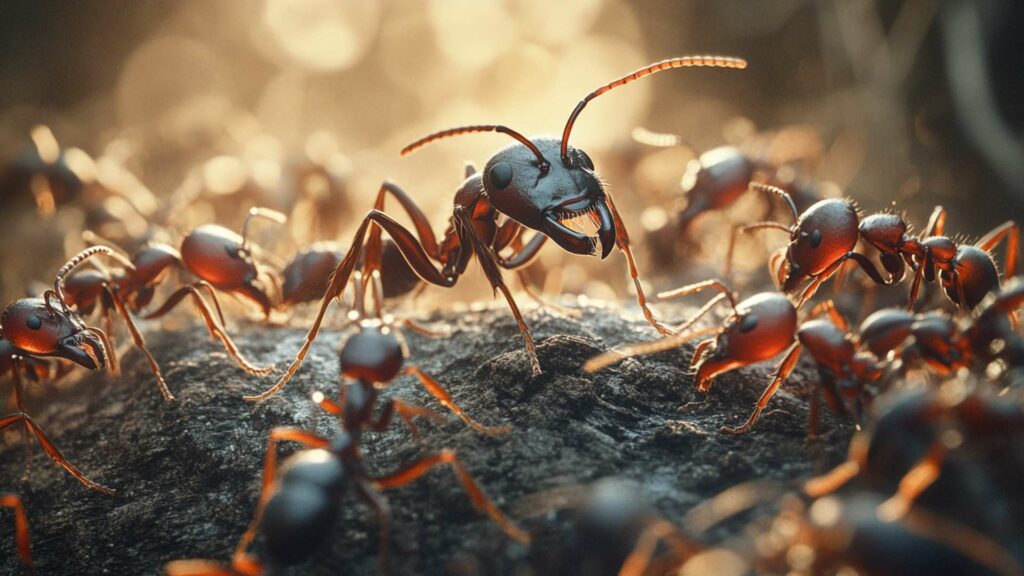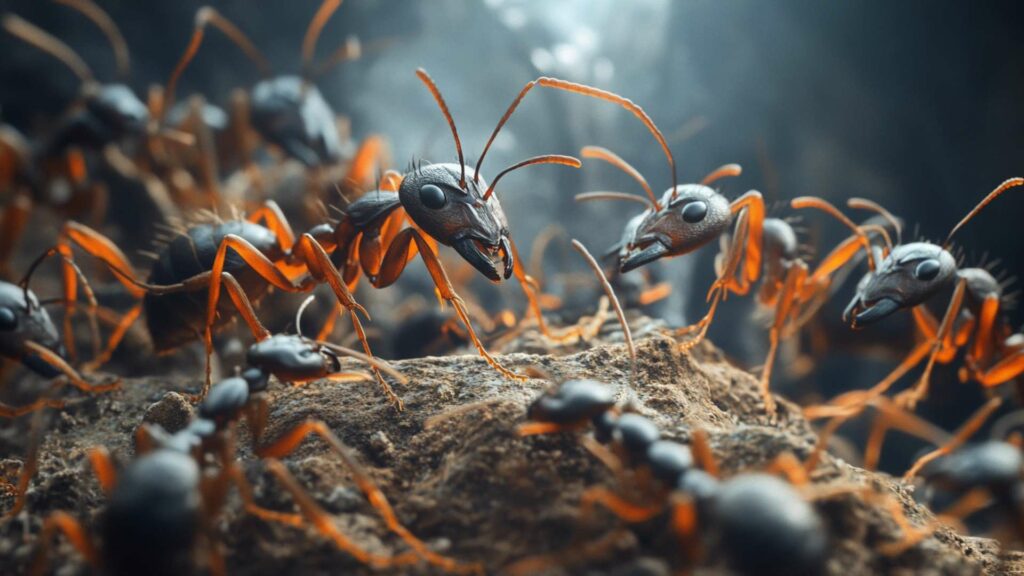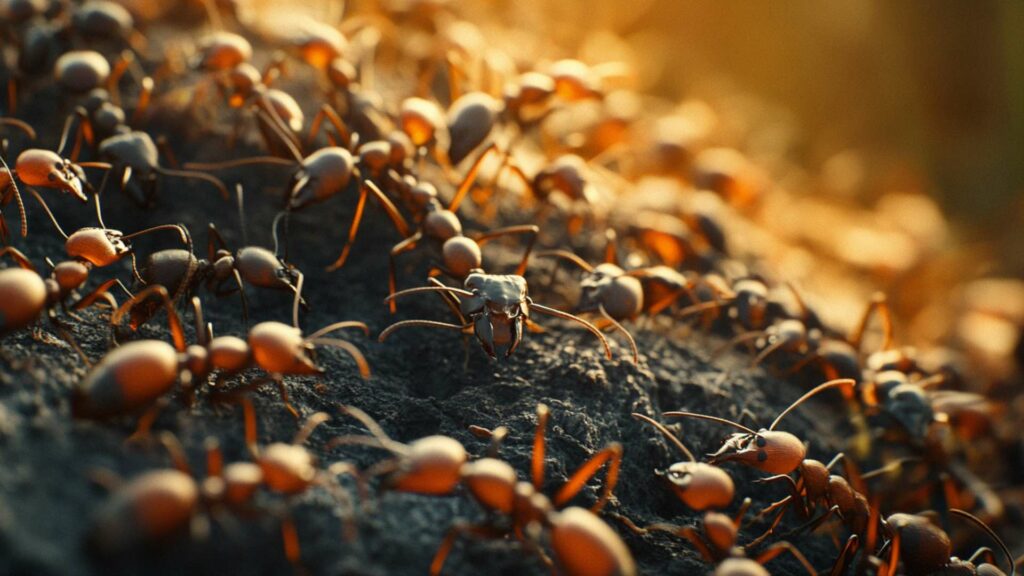Welcome to the fascinating world of ants, where these tiny creatures never cease to amaze us with their intricate behaviors and complex social structures. Ants, with their highly organized colonies and various species, have captivated the attention of scientists and casual observers alike for centuries. Among the many curiosities surrounding these industrious insects, one question that often arises is: do ants sleep?
The Fascinating World of Ants

Ants are incredibly diverse creatures, with over 12,000 known species worldwide. Each species of queen ant has its own unique characteristics and adaptations that contribute to their success in different environments.
From the mighty leafcutter ants that can strip entire forests bare to the industrious harvester ants who tirelessly gather seeds for their colonies, there is an incredible range of behaviors and roles within ant societies. Ants form elaborate nests in a variety of habitats such as soil, trees, or even underground tunnels.
These nests serve as shelter not only for sleeping but also for rearing young ones and protecting food reserves. The complexity of ant colonies is astounding; they often consist of thousands or even millions of individuals working together harmoniously.
Curiosity about ants’ sleep patterns
Given the remarkable diversity and complexity found within ant societies, it’s only natural that researchers would be curious to find answers about whether ants experience sleep like humans do. Sleep is a fundamental behavior observed in many animals across different species but understanding how it manifests in insects remains an intriguing area of study.
While humans spend an average of 7-9 hours each day asleep in consolidated periods during the night, we wonder if worker ants also have similar patterns or if their sleep is distributed differently due to their unique lifestyle. Do worker ants take short naps throughout the day?
Do the queens sleep when queen fire ants fall into a deep sleep for hours? These questions have captured the attention of scientists like George Yanev, who have dedicated their research to uncovering the mysterious world of ant sleep patterns.
Overview of Ants’ Sleep
Mysterious Slumber in Little Creatures: As we delve into the intriguing world of ants, one can’t help but wonder about their sleeping habits. Do these industrious insects take a break from their tireless work to rest? The concept of sleep is not uncommon in the animal kingdom, but do ants, with their busy lives and bustling colonies, also require periods of slumber?
To understand ants’ larvae’ sleep patterns better, let us first explore what sleep means for insects as a whole. The Definition Dilemma: Defining sleep in insects isn’t as straightforward as it is for humans.
Insects lack a central nervous system like ours, making it challenging to define sleep by using the same criteria. However, researchers have identified specific characteristics that distinguish insect sleep from being merely idle or resting.
Sleep is characterized by reduced mobility and responsiveness to stimuli while being reversible and exhibiting distinct behavioral changes. This definition allows us to discern whether ants engage in genuine slumber or merely take moments of rest throughout their frenzied lives.
Distinguishing Sleep from Rest: Within the ant world itself, there exists a distinction between sleep and rest. While rest generally refers to periods when ants temporarily pause activity without entering into a deep state akin to human sleep, true sleep involves more profound physiological changes that promote rejuvenation and restoration.
Understanding this difference helps us comprehend the various behaviors exhibited by these fascinating creatures in different states of repose. Let’s dive deeper into ant species’ specific sleeping patterns and shed light on how they balance work and rest within their complex societies.
Sleep Patterns in Different Ant Species
Sleep is a fascinating aspect of an ant’s life, and their sleep patterns vary across different species. Most ants adopt a polyphasic sleep pattern, which means they take short, frequent naps throughout the day and night.
Unlike humans who typically require long periods of uninterrupted sleep, ants have adapted to maximize their productivity and responsiveness by taking these short power naps. These short bursts of rest allow them to conserve energy while staying active for longer periods.
In many species of ants, including the industrious worker ants that tirelessly protect and gather food for other ants in their colonies, these short naps are the norm. They will take quick breaks from their laborious tasks to rest for a few minutes before resuming their duties.
Research conducted by entomologist Devon Swick in South Florida has shown that fire ant workers commonly take hundreds of these mini-snoozes each day! This ability to rejuvenate themselves with frequent rests enables them to keep up with the relentless demands of their colony.
Monophasic sleep: Rarely observed in certain ant species
While polyphasic sleep is prevalent among most ant species, there are some exceptions where monophasic sleep has been observed. Monophasic sleep refers to longer, consolidated periods of sleep during specific times rather than multiple shorter naps spread throughout the day and night.
Certain ant species exhibit monophasic sleep patterns either due to environmental factors or specific requirements within their colonies. For example, queen ants often engage in monophasic sleep during particular stages of colony development or reproduction cycles.
These extended periods of rest allow them to conserve energy for vital activities like laying eggs and ensuring colony growth. Interestingly, some studies suggest a correlation between environmental factors and monophasic sleeping habits in certain ant species.
For instance, ants in regions with extreme weather conditions, such as the hot and dry regions of the desert, may adopt monophasic sleep patterns to avoid the harsh daytime temperatures. By resting during the hottest hours of the day, they can survive better and maintain their activity levels at night when it’s cooler and more favorable for foraging.
The sleeping habits of ants provide a captivating glimpse into their intricate lives. From short naps to consolidated periods of rest, these remarkable creatures have adapted diverse sleep patterns to optimize their survival and efficiency within their colonies.
Factors Influencing Ants’ Sleep Patterns
Ants, those diligent little creatures, possess an internal biological clock that regulates their sleep patterns. This clock—known as the circadian rhythm—plays a vital role in synchronizing ants’ sleep-wake cycles with the day-night cycles of their environment.
Just like humans, ants have evolved to be active during the day and rest at night. This synchronization ensures that ants are most active when food sources are available and predators are less active.
The circadian rhythm impacts not only the timing of sleep but also the activity levels and rest periods of ants. As daytime approaches, ants gradually become more active, preparing themselves for foraging and other tasks necessary for colony survival.
Similarly, as dusk settles in, their activity levels decrease, signaling the onset of rest periods. This internal biological clock helps optimize ant colonies’ productivity by aligning their energy-intensive activities with daylight hours while allowing them to recharge during periods of relative safety when predators are less likely to be prowling around.
Environmental Cues: External Factors Affecting Sleep Behavior
In addition to their circadian rhythm, ants’ sleep patterns are influenced by a variety of external factors collectively referred to as environmental cues. These cues include light intensity, temperature fluctuations, and humidity levels within their habitat. Light intensity plays a crucial role in regulating ants’ sleep-wake cycles.
Bright sunlight acts as a signal for increased activity as it mimics daylight conditions when they should be most awake and productive. Conversely, dark, dim, or low-light conditions indicate nighttime or darkness when it’s time for these hard-working insects to retreat into slumber.
Temperature and humidity also affect ants’ sleep habits significantly. As ectotherms (cold-blooded organisms), ants rely on external temperatures to regulate their metabolic rates.
Generally, ants are more active and require less sleep when temperatures are warm, while colder temperatures slow them down, increasing their need for rest. Humidity levels also impact ants’ sleep patterns as excessive moisture can disrupt their ability to function properly and lead to decreased activity.
Through millions of years of evolution, ants have adapted to optimize their survival and energy conservation by closely aligning their sleep patterns with environmental cues. These adaptations ensure that these tiny creatures can make the most out of their waking few hours a day while finding ample time to rest and rejuvenate for another day of diligent work in their complex colonies.
Sleeping Habits Inside the Ant Colony

Sleeping arrangements within the nest structure
Inside the intricate world of ant colonies, we find a fascinating array of sleeping arrangements tailored to suit each species’ unique needs. Different ant species have evolved various strategies to ensure restful slumber for their hardworking inhabitants.
One common approach is the provision of specialized chambers or galleries within the nest structure that serve as designated areas for resting purposes. These chambers are often strategically located in quieter and more secluded parts of the colony, providing a peaceful environment for ants to unwind after their tireless endeavors.
Specialized chambers or galleries for resting purposes
Ants have mastered the art of creating cozy domiciles even within their subterranean abodes. These specialized chambers or galleries, distinct from other sections of the nest, are carefully crafted with specific features catered towards promoting restful sleep.
These tiny sanctuaries are typically lined with soft materials like larval silk or bits of plant matter, ensuring comfort and insulation from external disturbances. Some species even create separate “bedrooms” for different groups within the colony hierarchy, such as workers, soldiers, and queens.
Organized shifts for different tasks within the colony
In an ant colony, sleep is not a solitary affair but rather a synchronized dance performed by its industrious inhabitants. Ants display remarkable organizational skills when it comes to managing their work-rest cycles efficiently. Just like a well-coordinated team, they divide themselves into organized shifts dedicated to specific tasks within the colony’s daily routine.
For instance, workers may alternate between gathering food outside and resting inside while others take over responsibilities. This division ensures that essential functions continue uninterrupted while allowing sufficient time for individual ants to recharge their energy levels.
Communication during rest periods
Communication is crucial in all aspects of ant life, including rest periods. Ants possess a complex system of chemical signals transmitted through their antennae, which they use to indicate their resting state. These chemical cues help the ants communicate with one another and maintain cohesion within the colony.
By emitting specific pheromones or substances during sleep, ants let other members know that they are in a period of rest and should not disturb them. This communication ensures that the entire colony understands when it’s time for some shut-eye and avoids needless disruptions.
Coordination for efficient transitions between active and resting phases
The transition between active and resting phases is a delicate process that requires coordination among the ant workers. They have developed intricate mechanisms to smoothly shift from one state to another without causing chaos within the colony. The coordination involves subtle cues exchanged among ants to signal when it’s time to switch between work mode and sleep mode.
These cues serve as gentle reminders to individuals that they should wrap up their current activities and prepare for some well-deserved rest or return to duty after rejuvenating slumber. Sleeping habits inside an ant colony are anything but haphazard affairs.
Ants have evolved sophisticated strategies to ensure peaceful rest within their nests, such as providing specialized chambers for sleeping purposes, organizing shifts for different tasks, employing chemical communication signals during rest periods, and coordinating transitions between active and resting phases effectively. These little creatures demonstrate remarkable adaptability in managing their sleep patterns while maintaining optimal functionality within their bustling communities.
Unusual Sleeping Behaviors in Ants

When it comes to ants’ sleeping habits, there’s an intriguing phenomenon known as power napping. Just like us humans, ants also need some rest during their busy work schedules. However, instead of taking long breaks or retreating to designated sleeping areas, ants have developed a remarkable ability to power nap while maintaining a level of sense of alertness.
These power naps typically last nine hours except for short durations, ranging from a few seconds to a couple of minutes. During these brief moments of rest, the sleeping ants manage to stay partially awake and responsive to their surroundings.
This unique behavior allows them to quickly rejuvenate and recharge their energy levels without compromising their duties within the colony. It’s as if they have mastered the art of multitasking by seamlessly blending periods of rest with their tireless work ethic.
Brief Moments of Rest While Maintaining Alertness
In addition to power napping, there are instances where ants exhibit subtle signs of restfulness while remaining vigilant and alert. These brief moments of rest are more subtle compared to power naps but serve the purpose of providing some respite without completely dozing off. You may observe a worker ant momentarily pausing amidst its activities, seemingly catching its breath before swiftly resuming its tasks.
During this time, its movements may slow down slightly as it takes a momentary break from its relentless bustling around the colony. Despite appearing still and calm on the surface, these resting ants remain fully aware of their surroundings and ready to spring back into action at any given moment.
Conclusion
While it may be surprising for some people to learn that even tiny creatures like ants take time for restful moments, it is clear that sleep plays a crucial role in their lives too. Through power napping during work breaks and brief periods of rest while maintaining alertness, ants have devised clever strategies to balance their tireless work ethic with the need for rejuvenation. As we delve deeper into the sleeping patterns of these industrious creatures, it becomes increasingly evident that ants do sleep, albeit in unique ways that suit their social structure and survival needs.
The remarkable adaptability displayed by ants in their sleep behavior is a testament to their resilience and efficient organization within ant colonies. So next time you come across a bustling ant trail, take a moment to appreciate the hidden world of restful moments amidst their tireless pursuit of building and sustaining their colonies.
Ward Off Ants with D-Termination: The Leading Pest Control Service in Las Vegas!

Confronted by ant infestations? Let D-Termination be your solution. Our highly skilled team specializes in deterring ants, rejuvenating cleanliness and integrity in your surroundings. Bid farewell to ants—select D-Termination for top-notch pest control today!
Get in touch with us at 702-919-6310 or visit dtermination.com to schedule your ant control service and take back your space from these unwelcome pests.
Frequently Asked Questions:
Ants have short periods of rest, but it’s not exactly sleep as we understand it.
It’s challenging to discern if an ant is sleeping due to their minimal rest periods.
Ants are often active at night, foraging for food and tending to their colonies.
Ants do not have emotions or feelings like humans; their behavior is primarily driven by instincts and chemical signals.







